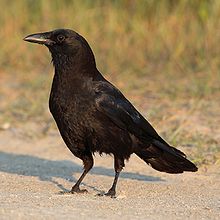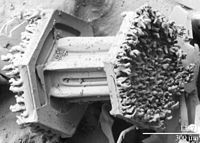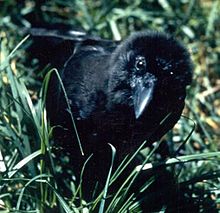
Hi Everybody!!
I finally got some "Wintry Precipitation". At 5:30am, I heard a strange noise and went to look outside. It appeared like a giant bean bag chair in the sky had exploded and millions of styro balls were bouncing on my deck and in the grass. Now, I have never seen anything like this, but you know who knew what it was: Google Search! Turns out the little balls are called Graupel. I have shared below the Wikipedia excerpt from the page on Graupel so everyone can know what was falling from the skies over the States. Included in my wintry mix are some birds I do know: the hummer, a buzzard and a cold crow. Enjoy!

Through the icy window in 28 degrees, Here He Comes!!!!!

Link to photostudy in G+ Albums:
https://plus.google.com/u/0/photos/117645114459863049265/albums/5977512287125780513





https://en.wikipedia.org/wiki/Graupel
Graupel
From Wikipedia, the free encyclopedia
Graupel (German pronunciation: ['gʁaʊpɛl]; English /ˈɡraʊpəl/, also called soft hail or snow pellets)[1] refers to precipitation that forms when supercooled droplets of water are collected and freeze on a falling snowflake, forming a 2–5 mm (0.079–0.197 in) ball ofrime. Strictly speaking, graupel is not the same as hail or ice pellets.
While graupel is sometimes referred to as small hail, the World Meteorological Organization defines small hail as snow pellets encapsulated by ice, a precipitation halfway between graupel and hail.[2]
The term graupel is the German word for the described meteorological phenomenon.[3]Its METAR code is GS.
Formation[edit]
Under some atmospheric conditions[which?], snow crystals may encounter supercooled waterdroplets. These droplets, which have a diameter of about 10 µm (0.00039 in), can exist in the liquid state at temperatures as low as −40 °C (−40 °F), far below the normal freezing point. Contact between a snow crystal and the supercooled droplets results in freezing of the liquid droplets onto the surface of the crystal. This process of crystal growth is known as accretion. Crystals that exhibit frozen droplets on their surfaces are referred to as rimed. When this process continues so that the shape of the original snow crystal is no longer identifiable, the resulting crystal is referred to as graupel.[4] Graupel was formerly referred to by meteorologists as soft hail. However, graupel is easily distinguishable from hail in both the shape and strength of the pellet and the circumstances in which it falls. Ice from hail is formed in hard, relatively uniform layers and usually falls only during thunderstorms. Graupel forms fragile, oblong shapes and falls in place of typical snowflakes in wintry mix situations, often in concert with ice pellets. Graupel is also fragile enough that it will typically fall apart when touched.[5]
Microscopic structure[edit]
The frozen droplets on the surface of rimed crystals are hard to resolve and the topography of a graupel particle is not easy to record with a light microscopebecause of the limited resolution and depth of field in the instrument. However, observations of snow crystals with a low-temperature scanning electron microscope(LT-SEM) clearly show cloud droplets measuring up to 50 µm (0.00197 in) on the surface of the crystals. The rime has been observed on all four basic forms of snow crystals, including plates, dendrites, columns, and needles. As the riming process continues, the mass of frozen, accumulated cloud droplets obscures the identity of the original snow crystal, thereby giving rise to a graupel particle.[4]
Graupel and avalanches[edit]
Graupel commonly forms in high altitude climates and is both denser and more granular than ordinarysnow, due to its rimed exterior. Macroscopically, graupel resembles small beads of polystyrene. The combination of density and low viscosity makes fresh layers of graupel unstable on slopes, and layers of 20–30 cm (7.9–11.8 in) present a high risk of dangerous slab avalanches. In addition, thinner layers of graupel falling at low temperatures can act as ball bearings below subsequent falls of more naturally stable snow, rendering them also liable to avalanche.[6] Graupel tends to compact and stabilise ("weld") approximately one or two days after falling, depending on the temperature and the properties of the graupel.[7]




https://en.wikipedia.org/wiki/Crow
Crow
From Wikipedia, the free encyclopedia
Crows (/kroʊ/) are members of a widely distributed genus of birds, Corvus, in the familyCorvidae. Ranging in size from the relatively small pigeon-size jackdaws (Eurasian andDaurian) to the Common Raven of the Holarctic region and Thick-billed Raven of the highlands of Ethiopia, the 40 or so members of this genus occur on all temperatecontinents except South America, and several islands. In Europe, the word "crow" is used to refer to the Carrion Crow or the Hooded Crow, while in North America it is used for theAmerican Crow or the Northwestern Crow.
The crow genus makes up a third of the species in the Corvidae family. Crows appear to have evolved in Asia from the corvid stock, which had evolved in Australia. The collective name for a group of crows is a flock or a murder.[1]
Recent research has found some crow species capable of not only tool use but also tool construction[2] and meta-tool use. Crows are now considered to be among the world's most intelligent animals[3] with an encephalization quotient approaching that of some apes[cit
| Crow | |
|---|---|
 | |
| American Crow (Corvus brachyrhynchos) | |
| Scientific classification | |
| Kingdom: | Animalia |
| Phylum: | Chordata |
| Class: | Aves |
| Order: | Passeriformes |
| Family: | Corvidae |
| Genus: | Corvus Linnaeus, 1758 |
Behavior
Calls
Crows make a wide variety of calls or vocalizations. Crows have also been observed to respond to calls of other species; this behavior is, it is presumed, learned because it varies regionally. Crows' vocalizations are complex and poorly understood. Some of the many vocalizations that crows make are a "Koww", usually echoed back and forth between birds; a series of "Kowws" in discrete units; a long caw followed by a series of short caws (usually made when a bird takes off from a perch); an echo-like "eh-aw" sound; and more. These vocalizations vary by species, and within each species they vary regionally. In many species, the pattern and number of the numerous vocalizations have been observed to change in response to events in the surroundings (e.g. arrival or departure of crows).
Intelligence[edit]
As a group, crows show remarkable examples of intelligence. Natural history books from the 18th century recount an often-repeated, but unproven anecdote of "counting crows" — specifically a crow whose ability to count to five (or four in some versions) is established through a logic trap set by a farmer.[7][8] Crows and ravens often score very highly on intelligence tests. Certain speciestop the avian IQ scale.[9] Wild hooded crows in Israel have learned to use bread crumbs for bait-fishing.[10] Crows will engage in a kind of mid-air jousting, or air-"chicken" to establish pecking order. Crows have been found to engage in feats such as sports,[11] tool use, the ability to hide and store food across seasons, episodic-like memory, and the ability to use individual experience in predicting the behavior of environmental conspecifics.[12]
One species, the New Caledonian Crow, has also been intensively studied recently because of its ability to manufacture and use its own tools in the day-to-day search for food. These tools include "knives" cut from stiff leaves and stiff stalks of grass.[13] Another skill involves dropping tough nuts into a trafficked street and waiting for a car to crush them open.[14][15] On October 5, 2007, researchers from the University of Oxford, England, presented data acquired by mounting tiny video cameras on the tails of New Caledonian Crows. It turned out that they use a larger variety of tools than previously known, plucking, smoothing, and bending twigs and grass stems to procure a variety of foodstuffs.[16][17] Crows in Queensland, Australia, have learned how to eat the toxic cane toad by flipping the cane toad on its back and violently stabbing the throat where the skin is thinner, allowing the crow to access the non-toxic innards; their long beaks ensure that all of the innards can be removed.[18][19]
The Jackdaw and the European Magpie have been found to have a nidopallium approximately the same relative size as the functionally equivalent neocortex in chimpanzees and humans, and significantly larger than is found in the gibbon.[20]
Crows have demonstrated the ability to distinguish individual humans by recognizing facial features.[21]
Evidence also suggests that they are one of the few non-human animals capable of displacement (linguistics) (communicating about things that are happening in a different spatial or temporal location to the here and now).[22][23]
Diet[edit]
Crows are omnivorous, and their diet is very diverse. They will eat almost anything, including other birds, fruits, nuts, mollusks, earthworms, seeds, frogs, eggs, nestlings, mice and carrion. The origin of placing scarecrows in grain fields resulted from the crow’s incessant damaging and scavenging, although crows assist farmers by eating insects otherwise attracted to their crops.[24]
Life span and disease[edit]
Crows reach sexual maturity around the age of 3 years for females and 5 years for males. Some crows may live to the age of 20, and the oldest known American crow in the wild was almost 30 years old.[25] The oldest captive crow documented died at age 59.[26]
The American crow is highly susceptible to the recently introduced North American strain of West Nile virus.[27] American crows typically die within one week of acquiring the disease and very few survive exposure.
Conservation status[edit]
Two species of crow have been listed as endangered by the U.S. Fish and Wildlife Service: The Hawaiian Crow and the Mariana Crow.[28] The American Crow, despite having its population reduced by 45% since 1999 by the West Nile Virus, is considered aSpecies of Least Concern.




Link to photostudy in G+Albums:
https://plus.google.com/u/0/photos/117645114459863049265/albums/5976754131463707505

...this is brendasue signing off from Rainbow Creek. See You next time!

Goodnight and Sweet Dreams!

O+O






No comments:
Post a Comment
Hi Everybody! Please say hello and follow so I know you are here! Due to the inconsideration of people trying to put commercials on my blog comment area, I have restricted use of anonymous posts. Sorry that some hurt all.
My public email is katescabin@gmail.com No spammers or trolls